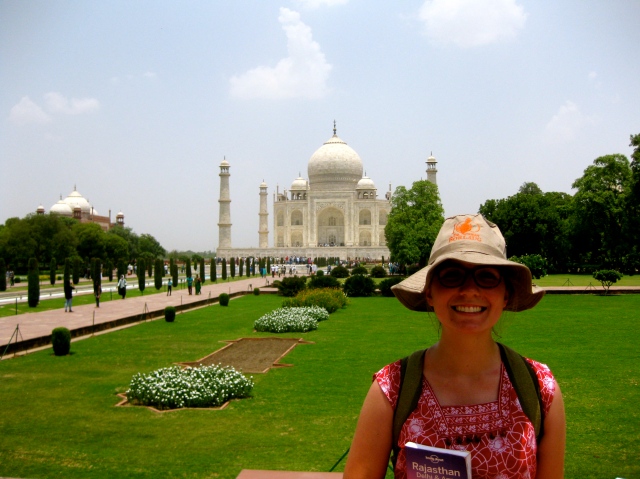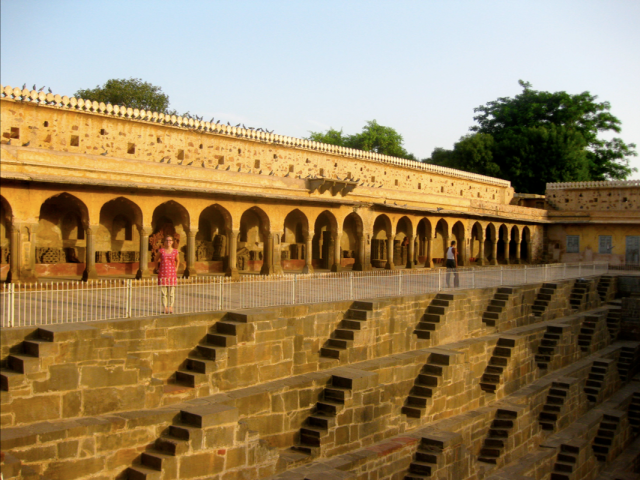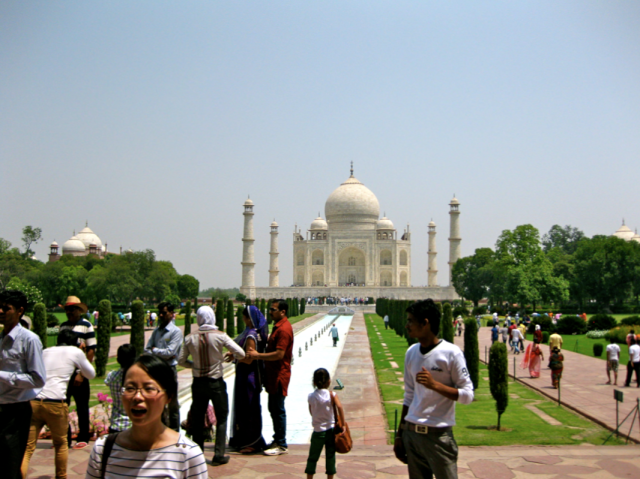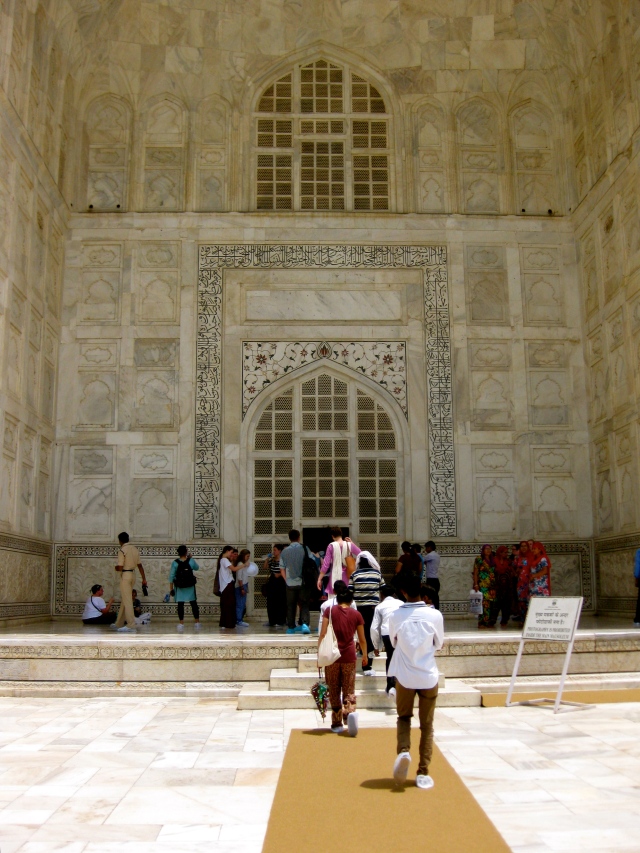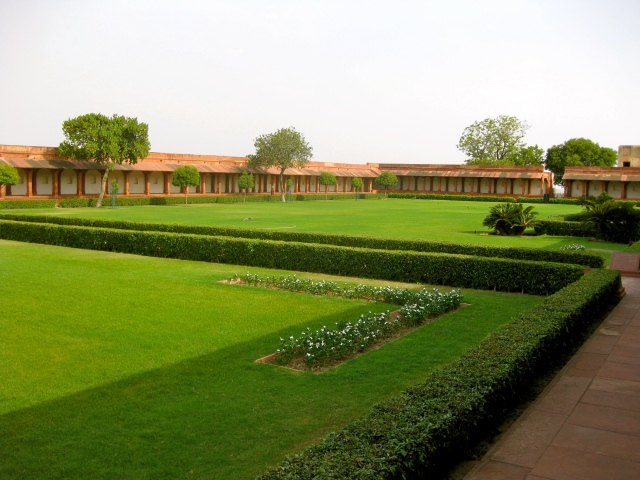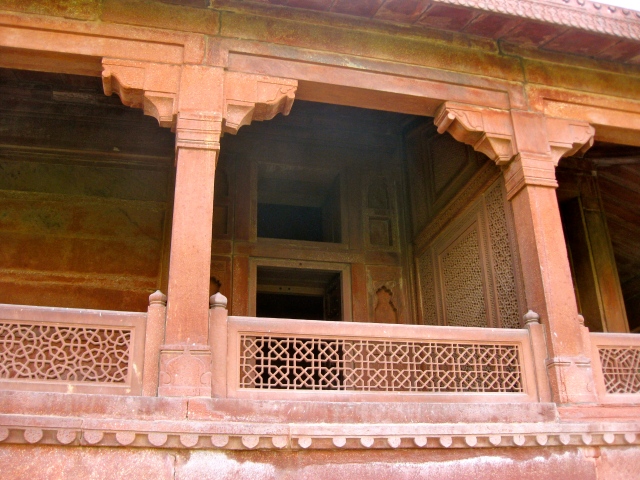Well, I saw the Taj. Wow. What a powerful place.
So powerful in fact that now my body feels like it got hit by a train.
Since the bus that we had rented to take us to Agra picked us up at 4 in the morning yesterday, all nine of us packed into Beverly and Rebekah’s houses (on the same street) to avoid having to pick everyone up in the morning. At Beverly’s house, the six of us, all girls, naturally gabbed the night away in full-on sleepover fashion and only ended up getting about two hours of sleep before crawling into the bus with the moon still full and promptly passing out.
Off the Agra-Jaipur highway lives a little gem called the Chand Baori stepwell. I’d read about it in a guidebook and had been itching to go, but I simply figured the driver would never be able to find it or it would be too far out of the way to make a stop at en-route to Agra. Most of us had slept the entire first part of the bus ride until Shin roused us in the morning light and whispered, “Guys, wake up, we’re at the stepwell.” I couldn’t believe we’d actually made the stop!
Umm, wow. The Chand Baori stepwell was constructed in 8th century and is one of Rajasthan’s oldest remaining pieces of history. The climate in Rajasthan is very dry and arid, and even today water scarcity is a constant concern. The well was designed to conserve as much water as possible, and the temperature near the bottom is 5-6 degrees cooler than at the surface level. In times of great heat, the bottom of the well was used as a community-gathering place.
At the break of day, the steps looked beautiful and ethereal in the morning light. Although the well was entirely fenced off to prohibit entrance, I could still imagine ladies in colorful clothing making their way down the steep steps to the well below. Located in the small village of Abhaneri, the place was devoid of much activity in the early morning, making for a very peaceful stop on our way to Agra. I would highly recommend renting transportation for the trip between Agra and Jaipur as the Chand Baori is well-worth the stop but harder to access via public transportation.
Having all once again passed out on the bus, we arrived in Agra before we knew it. First stop: The Taj Mahal. In 2002, the Taj Mahal began to show signs of discoloration from pollution. After using multani mitti – an ancient blend of soil, cereal, milk, and lime once used by Indian women as a beauty product – to spruce up the color, the city prohibited the operation of polluting vehicles within a zone surrounding the Taj. Only electric vehicles are allowed, so our bus driver had to drop us at the edge of the zone.
Entry into the Taj is expensive, almost $13. You wouldn’t typically find an entrance fee that high elsewhere in India. Admission includes a free bottle of water and thin cloth booties to be worn over your shoes. My guidebook recommended skipping the booties to help the environment and simply walking barefoot on the Taj like the locals do. In July, this was a huge mistake, which I’ll get into later.
After being bombarded by relentlessly pushy guides looking for work, we boarded an electric vehicle (it reminded me of the Trumpet Creeper at the MN Arboretum) that dropped us at the gate. I’d heard horror stories of three hours lines under the hot sun outside the Taj but was surprised to find no line. Again, it became obvious why this was the case later on.
From the south, the Taj grounds are accessed by a massive red sandstone gateway inscribed with verse from the Quran. The top of the Taj peeks into the southern entry courtyard from afar.
The gateway spits you out into a tangle of tourists in a small space all trying to get the same picture at the same time. But you also see the Taj in all of its glory for the first time. It was very much an inspiring moment that definitely gave all of us the chills. It’s just one of those things that you think you’ll never see in your life. Even just a year ago, before my internship at the seed company, India wasn’t even really a country I was thinking about.
I’ve questioned myself a lot since I arrived in India: Shouldn’t I be doing science right now? What am I getting out of this experience? What am I doing with my life? I have such a huge life change coming up in a few weeks. The added day-to-day stress that comes along with simply living and functioning in India definitely exacerbates all of that questioning, but in moments like seeing the Taj for the first time, I am reminded that I must be doing something right.
A large Persian garden fills the space in between the Taj and the red sandstone gateway, quartered by long narrow fountains. I had seen so many beautiful photographs of the Taj reflecting in these fountains, but apparently they had had a bad case of India in July yesterday and were empty. Midway through the gardens, the picture-takers had thinned out, so we stopped to capture some quintessential “me at the Taj” photos and attempt some derpy selfies before moving on.
When I arrived at the foot of the Taj, I got a true sense of the sheer size of the structure for the first time. The variety in color and pattern of the marble blocks also became visible.
Time to go up inside. I climbed the steps onto the marble platform and removed my shoes. Ow. Let’s see, how to describe the feeling of the flesh on the bottom of your feet burning? I momentarily felt as though my life depended on getting to piece of the floor that was in the shade. Although I had rejected the booties earlier at the advice of my guidebook, thankfully there was a stand nearby dispersing the cloth booties. I got myself a pair and made my way back up the steps.
It was 107 degrees yesterday. I really don’t even want to know how hot the white stone marble was, but it noticeably hotter on top of the platform than below in the courtyard. The Taj itself sizzles your corneas, which felt almost symbolic to me. The white stone reflects so much light that you must have one eye closed at all times to simply be up there. I had debated bringing along a very touristy-looking bucket hat, but I was extremely grateful to have had it. Some of the students in my group had brought neither a hat nor sunglasses and really struggled. It made sense why there weren’t the busloads of tourists piling into the Taj yesterday, which was nice, but I can’t deny that the heat really made it a challenge for us.
Photography inside the tomb was prohibited, so I don’t have any photos to share from it, but it was relatively simplistic. The false tomb of Shah Jahan’s wife, Mumtaz Mahal, was in the center. Shah Jahan’s cenotaph was off to the left, both surrounded by a beautiful marble screen inlaid with semiprecious stones. The real tombs are locked away in the basement.
The inside of the tomb was a madhouse of people pushing and shoving to get a view of the cenotaphs. One incredibly annoying boy behind me decided it would be a good idea to test the acoustics of the tomb, screaming and shouting the entire time. Ugh.
Once out the other side, we spent some time marveling at the great detailing in the marble walls of the Taj, the nearby mosque and symmetrical jawab, and the sadly dried up-looking Yamuna River. Being around there made me think a lot about human emotion and what would have driven Shah Jahan to construct such a place.
I now have a great answer for that annoying dinner party question of what time period in history you would choose to be alive during: the Islamic Mughal empire in India. The Mughals were in power in India from 1526 to 1857, and the 17th century in particular marked a time of peace and prosperity for India. That time became a sort of golden age for architecture in India as Shah Jahan erected many large monuments, several of which are now some of the most famous sites in India. For example, last weekend I saw the Jama Masjid and the Red Fort in Delhi, both of which were built by Shah Jahan. In Agra, the Taj Mahal is perhaps Shah Jahan’s masterpiece, but he also contributed to the Agra Fort, itself a UNESCO World Heritage Site that we didn’t have time to make it to. His grandfather Akbar had built the Fatehpur Sikri two generations before.
Supposedly court records detail Shah Jahan’s grief and subsequent demise in response to the loss of his third wife Mumtaz Mahal during the birth of their 14th child. While I would like to believe the driving force behind the construction of the Taj – which employed over 20,000 people, brought in artisans from as far away as Europe, and required the refinement of thousands of semiprecious stones – was love, I can’t help but wonder if there might have been a little bit (or big bit) of an ego involved. We enjoyed speculating about the personality of the great Shah Jahan and what it was that drove him to build one of the most iconic structures in the world.
With last look back at the Taj one final time (although I’m sure I will be back someday!), we hit the road and made our way for Fatehpur Sikri. An hour in the direction of Jaipur outside of Agra, the Fatehpur Sikri was the short-lived capital of the Mughal Empire from 1571 to 1585. Built by Emperor Akbar on a piece of land prone to water scarcity, the series of palaces and other structures were abandoned after the emperor’s death. The structures remain today as one of the best preserved examples of Mughal architecture.
Group moral was low when we arrived at the Fatehpur Sikri. Despite having had a lunch break at an overpriced restaurant that our driver dropped us off at so that he could make commission, we hadn’t recovered from the severe heat. We wandered mindlessly from building to building in the oppressive heat but still appreciated the beautiful architecture.
My favorite part was the huge Diwan-i-Am, the Hall of Public Audiences. The huge courtyard is said to have hosted public executions in which elephants would trample the convicted. A pavilion headed the courtyard, and I was able to imagine Akbar himself dispensing justice from the center section of it.
Just outside the Fatehpur Sikri is a Jama Masjid mosque also constructed by Akbar. After my last experience at the Jama Masjid in Delhi, I was so excited to check this place out! Even before we can get through the entryway, it’s all, “Hello, miss where you are from?” Ugh… People would NOT leave us alone at this place. Many of my counterparts in the program are much more engaging with Indian people than I am, and a lot of the time I get down on myself about that fact, but at the Jama Masjid, I was happy I had enough gumption to give all the chatty fellows the cold shoulder. Many of my friends in the group got pulled away to pay money to make an offering. Poor Shin got so wrapped into one chap’s scheme that she spent 1500 rupees on cheap stone carvings! That’s a whopping $25! This little boy wouldn’t get off my toes for about twenty minutes inside the mosque, asking for my used ticket to the Fatehpur Sikri, which we assumed he would turn around and try to sell to unsuspecting tourists. He followed me out of the mosque, road our rickshaw back to the entrance with us, and followed us all the way to our bus, banging on the sides as we pulled away. Being there was just so acutely annoying. I couldn’t really appreciate the mosque as a result, but I still managed to snap a few decent photos of it (most of which were taken when I was trying to make myself look like I was occupied to avoid the “Hello Miss” chaps):
I even recorded a video of the 5 o’clock call to prayer:
I’m starting to feel like I’ve recovered a bit since I started working on this post this morning. Right now I’m down in Refill Cafe below the Domino’s near Gaurav Towers. My housemate Ben showed me this place today. The WiFi is a huge improvement over the institute’s and the USB internet stick I own, and we even got to share some masala French fries and a couple of chocolate covered waffles. Can’t beat that!
What a trip! This trip, just like Delhi, chewed me up and spit me out. We had some of the best and some of the worst experiences together, which I’m starting to believe properly sums up travel in India. The Taj Mahal is now thoroughly seared into my corneas. Kidding! Despite the heat, I am so grateful to have had the opportunity to take in the Taj, Fatehpur Sikri, and the stunning Baori Stepwell all on this one single trip. My travel will be winding down from here on out. This week we have Friday off, so Beverly and I are headed to the foothills of the Himalayas via sleeper train for three days of adventures and hopefully some relaxation. After a quick group trip to Pushkar, the camel town, I’ll be back in Jaipur for good until I come home to Minnesota on August 10th. Can’t believe the program is wrapping up so fast, but I really feel as though I’m making the most of it. Thanks for joining me for the Taj!

